
Several times in her podcasts I’ve heard Birdchick advise her listeners not to upgrade their field guide (provided their current one is no more than a decade old, or so). As the multitude of Extra Special [fill in the blank with some annoying, vaguely title-specific phrase] Edition DVD’s on my shelves would tell you, I would never go so far as to say that. But I would agree with her about this: if all the new guide does is update the taxonomy to conform with the latest updates from the AOU and ABA, then what’s the point? For it to be worth buying, any new or updated North American field guide needs to do more than be current with all the splits, lumps, and new species for the ABA area.
So what about the new, “fully revised and updated” sixth edition of the National Geographic Field Guide to the Birds of North America? The quick answer is that it is more than the fifth edition with updated taxonomy. Still, is it worth upgrading? I’m not prepared to give a pronouncement on that yet, but I must say that it includes some unique and useful additions. Once I’ve had time to really get into it I’ll post a full review with my opinions. But in the meantime, to help you make an informed decision, here is a breakdown of the new features and changes.
Species
At 990 species, this new one includes 23 more than the prior. Actually, there are 26 new birds as three have been removed: Dusky-headed Parakeet and Crested Myna from the main body; and Caribbean Elaenia from the Accidentals list. Five of the 26 new ones have been added to the main section: White-chinned Petrel, Rosy-faced Lovebird, White-eyed Parakeet, Red-lored Parrot, and Loggerhead Kingbird. The rest have been added to the Accidentals:
- Townsend’s Shearwater
- Swinhoe’s Storm-Petrel
- Tristram’s Storm-Petrel
- Bare-throated Tiger-Heron
- Intermediate Egret
- Sungrebe
- Solitary Snipe
- Swallow-tailed Gull
- European Turtle-Dove
- Brown Hawk-Owl
- Amazon Kingfisher
- White-crested Elaenia
- Crowned Slaty Flycatcher
- Gray-collared Becard
- Sinaloa Wren
- Sedge Warbler
- Rufous-tailed Robin
- Brown-backed Solitaire
- Song Thrush
- Red-legged Thrush
- Yellow-browed Bunting
Size
Thanks to these new additions, along with other changes, this sixth edition is a little larger than its predecessor. At 575 pages, it is 72 pages, or 14%, thicker. But this is negligible, I don’t think anyone carrying this guide will notice it.
Taxonomy
All the latest AOU changes have been incorporated here, including renaming Common Moorhen to Common Gallinule, the massive overhaul of warblers, and moving the longspurs and snow buntings from after the sparrows to just before the warblers.
Maps
The range maps have been revised based on the latest understanding of distribution. For instance, if you look closely at these sample maps you’ll see the isolated breeding population of Warbling Vireos in South Carolina is now indicated. Some maps, where appropriate, now show more area to the north, around Greenland, and to the south into Mexico. And there are some more noticeable changes as well. First, I’m sure you noted that the Warbling Vireo map has subspecies information on it. More about this shortly. Additionally, there are some new, shiny colors. Nowadays, it is worth noting when a field guide does not show the migration range. So it is not surprising that this has been added. But National Geographic took it a step further and included separate colors for spring, autumn, and both-way migration. This is the first guide I’m aware of to do that, and it is very helpful. [Update: Thanks to Georgann for reminding me that the old Golden Guide by Zim and Robbins also did this. That guide really was ahead of its time.] The Philadelphia Vireo map, for example, suggests that my best chance for seeing one where I live in Georgia is in the fall (yellow=fall migration and orange=both). And that is, indeed, the case.
The maps of 59 birds with multiple subspecies are marked to show the ranges of the constituent subspecies. For others, the maps are not large enough to include the necessary information, so there are new, larger subspecies maps for 37 species in the back. These appear very well done, and I’m looking forward to studying them further. But note, not all birds have their subspecies mapped.
Visual Index
The inside of the front and back covers now has a visual index to bird families.
Illustrations
The pointers and plate annotations introduced in the 2008 NatGeo Eastern and Western regional guides have been carried over here. I find these very useful and am glad they are here. They do not come without a cost, however. Most illustrations are reproduced slightly smaller than in the 5th edition in order to accommodate them.
The in-flight plates for ducks, raptors, shorebirds, and immature gulls are retained, but the in-flight illustrations have also been added to most of the regular accounts as well.
I’ve gone through this guide and compared it, plate-by-plate, to the previous edition. The front cover claims there are “300 new art pieces”. That wouldn’t surprise me. Here are all of the changes that I’ve found. Two caveats: I make no claims as to the comprehensiveness of this list, and some of these changes may have been made in the regional guides, but I don’t have those so I can’t be sure.
These species have been completely redone with new artwork, and in many cases additional images have been added. (Some of these changes were desperately needed.):

This completely redone plate is a huge improvement over the previous one (if you pardon the bad scan)
- Greater White-fronted Goose
- Bean Goose – split to Tundra and Taiga Bean-Goose, with new art
- Brant – more variation shown, all artwork replaced
- Baikal Teal
- Garganey
- Northern Fulmar – redone, with additional illustrations
- Great Shearwater
- Storm-petrels – all completely redone
- Northern Gannet
- Great Cormorant
- Neotropic Cormorant
- Reddish Egret
- Red-tailed Hawk
- King Rail
- Clapper Rail
- Virginia Rail
- Corn Crake
- Thick-billed Murre
- Rhinoceros Auklet
- Horned Puffin
- Tufted Puffin
- Common Cuckoo
- Oriental Cuckoo
- Goatsuckers – all have been completely redone, except Common Pauraque
- Sulphur-bellied Flycatcher
- Hutton’s Vireo
- Western Scrub-Jay
- Crows and Ravens – all redone (except Eurasian Jackdaw); in-flight and other illustrations added for most
- Brown Creeper – redone, now shows both eastern and southwestern
- Winter Wren
- Sedge Wren
- Marsh Wren – single illustration replaced by three: eatern (dissaeptus), south Atlantic coast (griseus), and western (aestuarinus)
- Ruby-crowned Kinglet
- Golden-crowned Kinglet
- Middendorff’s Grasshopper-Warbler
- Dusky Warbler
- Arctic Warbler
- Palm Warbler
- Louisiana Waterthrush
- Northern Waterthrush
- Wilson’s Warbler
- Common Yellowthroat
- Rufous-winged Sparrow
- Chipping Sparrow
- Clay-colored Sparrow
- Brewer’s Sparrow
- Savannah Sparrow
- Grasshopper Sparrow
- Lincoln’s Sparrow
- White-crowned Sparrow
- Gray Bunting
- Reed Bunting
- Little Bunting
- Pallas’s Bunting
- Rustic Bunting
- Painted Bunting
- Indigo Bunting
- Lazuli Bunting
- Varied Bunting
- Brown-headed Cowbird
- Bronzed Cowbird
- All 3 Rosy-finches
- Purple Finch
- Cassin’s Finch
- House Finch
- Common Rosefinch
Here are some further changes:
- Cackling Goose – “Richardson’s” redone
- Canada Goose – moffitti ssp added; flying illustration from below removed
- Swans – comparison of Trumpeter and Tundra bills added
- Mottled Duck – illustration of the “mainly Florida” fulvigula ssp added
- Green-winged Teal – female redone
- Cinnamon Teal – female redone
- Common Eider – adult and eclipse male v-nigrum removed, but added a comparison of male heads of all 4 subspecies
- Harlequin Duck – male redone
- Black Scoter – inset of Common Scoter added
- White-winged Scoter – illustration of “Velvet Scoter” added
- Common Goldeneye – illustration of courtship display removed
- Swan Goose – removed from Exotic Waterfowl
- Northern Bobwhite – added males of taylori and floridanus ssp
- Shy Albatross – “Salvin’s” illustration added
- White-tailed Tropicbird – added inset of Pacific adult head
- Brown Pelican – removed diving sequence and added breeding adult californicus
- Cattle Egret – coromandus ssp added
- Great Egret – modesta head inset added; high breeding adult modified slightly
- American Flamingo – in-flight added
- White-tailed Eagle – illustration of standing bird added
- Steller’s Sea-Eagle – illustration of standing bird added
- Red-shouldered Hawk – added two elegans in flight
- Ferruginous Hawk – added perched juvenile
- Raptors in Flight – most buteos redone; replaced adult accipiters with juveniles
- Common Gallinule – added inset of Eurasian Moorhen head
- American Oystercatcher – frazari ssp added
- Eskimo Curlew – moved to Accidentals section
- Semi-palmated Sandpiper – added breeding female
- Yellow-legged Gull – added winter adult atlantis
- Bridled Tern – first summer added
- Jaegers – for each: added standing light-morph/typical juvenile and head of light-morph/typical breeding adult
- Common Murre – in-flight illustration replaced
- Black Guillemot – added mandtii; added breeding adult in-flight
- Zenaida Dove – added female
- Smooth-billed Ani – sunning illustration removed
- Black Switf – both adult and juvenile have been slightly touched up
- Xantus’s Hummingbird – moved to Accidentals
- American Three-toed Woodpecker – added male and female bacatus and inset of dorsalis
- Willow Flycatcher – added 1st fall brewsteri
- Loggerhead Shrike – comparison of in-flight shrike and mockingbird redone
- Horned Lark – removed: juvenile and female alpestris (“Northern”); added: female, winter male and juvenile ammophila (“southwestern”)
- Purple Martin – added western female in flight
- Brown-chested Martin – moved to main section from Accidentals
- Willow Warbler – moved to main section from Accidentals
- Yellow-browed Warbler – moved to main section from Accidentals
- Northern Mockingbird – in-flight redone
- Snow Bunting – added 1st winter female in flight
- Bachman’s Warbler – moved to Accidentals
- Nashville Warbler – replaced immature female, added adult male ridgwayi
- Yellow Warbler – added immature female amnicola
- Yellow-rumped Warbler – replaced fall female Myrtle
- Yellow-breasted Chat – added head of female auricollis
- Western Spindalis – added male pretrei (from Cuba)
- Rufous-crowned Sparrow – coastal juvenile replaced with juvenile eremoeca
- Lark Sparrow – in-flight illustration removed
- Song Sparrow – juvenile melodia replaced with juvenile heermanni
- Fox Sparrow – “Red” redone
- Northern Cardinal – added southwestern male
- Eastern Meadowlark – added in-flight illustration
- Hooded Oriole – added male cucullatus
- Common Redpoll – added female rostrata
Posted by Grant McCreary on October 28th, 2011.











Great review! I’m thoroughly impressed what what I see here of the new Geo, but I already found a typo! The Nelson’s Sparrow ssp. “alterus” is labeled twice as “alter” on the map.
Honestly, with all the funky Latin names (at least to those of us who don’t deal with them constantly) I’m surprised there aren’t more misspellings!
Helpful review, Grant. Definitely time to upgrade from my old 3rd edition – the ssp maps will be very useful.
Michael, ‘alter’ is now considered the correct spelling for the Nelson’s Sparrow ssp.
Richard, could you please direct me to the source of this change? Even the Sharp-tailed Sparrow article in the current NAB uses alterus. Thanks.
Michael, alter is used by Dickinson 2003 (H&M3), citing David & Gosselin 2002 (Gender agreement of avian species names).
Also used by, eg, IOC, Zoonomen, Cornell (Clements), HBW16 (imminent!), BNA Online, and Alderfer 2006 (NG Complete Birds of N America).
There seem to be more and more grammatical corrections each year!
Hmm, my copy of Alderfer 2006 (NG Complete Birds of N America) and the subsequent 2008 “Eastern Geo” both list alterus.
Hmm, my copy of Alderfer 2006 (NG Complete Birds of N America) and the subsequent 2008 “Eastern Geo” both list alterus. From what I can tell, alterus is still the de facto spelling in North America. Since the AOU never updates subspecies names, I suspect we’re stuck with the 1957 names on this continent.
I see that BNA uses alter, but I suppose that’s not surprising since Cornell authors the Clements checklist! Thanks for the information, Richard!
Oops! Apologies, Michael. You’re right about Alderfer 2006. I mis-transcribed my too-quickly scribbled notes. But at least NG has evidently adopted ‘alter’ now.
Presumably AOU would concur. eg, AOU-SACC has recently implemented David & Gosselin’s 2011 grammatical corrections to species names (proposal 489, Richard C Banks), and a couple are pending with AOU-NACC (proposal 2011-A-6).
These corrections can be a pain in the butt, but are necessary to conform to The Code (ICZN).
In theory, I’m supportive of well-reasoned changes like this, but I do wonder, on a technical level, if we aren’t stuck with the 1957 names in North America. Since NACC is “the last word”, and the last word on subspecies was in 1957, how is anarchy averted if some sources start changing subspecies names? Surely, others won’t.
I’m not sure who you mean when you refer to being stuck with the 1957 names (although there will always be cases of independent authors not checking current sources and unknowingly using older taxonomy). The fact is that AOU no longer maintains a subspecific classification and cannot still be considered the last word on subspecies names – subspecific taxonomy can’t just be frozen at 1957.
All current major North American-based works concerned with subspecific taxonomy (Clements Checklist, IOC World Bird List, Zoonomen, BNA Online, and apparently NatGeo) have been consistent in applying grammatical corrections required by ICZN. [BNA Online is a joint CLO/AOU project.]
AOU is equally committed to following ICZN rules (The Code). The David & Gosselin 2002 corrections were therefore adopted for the AOU Check-list in the 44th Supplement, changing the endings of nine species names. Any subspecies names affected (including alterus) would surely also have been corrected if AOU was still maintaining a subspecific classification.
Hi, Richard. The “we” I was referring to are birders who depend on the AOU for taxonomy.
You said, “Any subspecies names affected (including alterus) would surely also have been corrected if AOU was still maintaining a subspecific classification.”
I don’t doubt this. What I doubt, though, is that the *de jure* subspecies names have changed. I can accept that the names have been updated de facto, but I doubt that they have been changed de jure. I’m certainly not making a practical argument, but rather, a “constitutional” one. If AOU has not changed something in writing since 1957, then it seems to be that what was printed in 1957 is still de jure in effect.
*seems to me
The book I have is the second edition, so I DO need to update!! 🙂 I’m trying to decide whether to buy the 5th or 6th edition. As I am new(er) to birding, I am not quite familiar with the book yet, and was excited when I saw that the 5th edition says it has thumb tabs… but I can’t find any confirmation online whether the 6th edition has these or not. Any help? Thanks!
Never mind… I just found this: http://www.birderslibrary.com/reviews/books/field/national_geographic_birds_sixth.htm
🙂